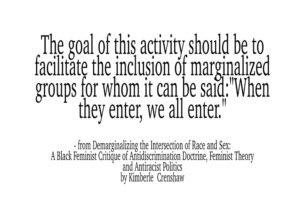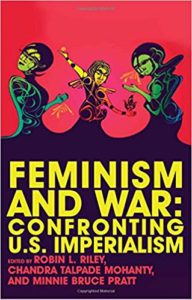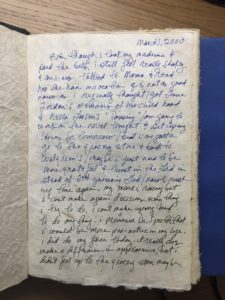This course has facilitated my understanding of myself, not just as a student or a feminist, but as a combination of all my identity markers in connection to my studies. As a Women’s, Gender and Sexuality Studies major, the first thing I think about whenever I consider myself in relationship to anything—be that academic or personal, is my feminism. As a result of my personal values and the ways that I have been trained to think as a student of my chosen discipline, my way of thinking revolves around questions of sex and gender. However, despite being a member of the feminism movement, I am also a heavy critic of feminism and its practices and policies. When I discuss my feminism, I feel that it is important to note that I come from an intersectional and transnational perspective. A lack of these two notions are my two biggest issues with the mainstream feminist movement that limit it’s potential for success. To me, intersectional feminism is about the consideration and incorporation of individual identity markers that work together to produce a more informed and inclusive type of feminist practice. Among these include race, gender, socio-economic background, ability status, family makeup, carrier status, etc., each of which functions as a different facet to inform a feminist ideology. Transnational, for me, means incorporating and adapting feminism to fit into the context of a particular physical or geographical location. Our class conversations have, in the past, noted the difference and challenges of acknowledging borders as a marker of physical difference and a way of facilitating the recognition of social and cultural different. Simultaneously, there is a need to disregard borders to unite women across the world under a similar plight. Too much of an emphasis on border risks creating a physical, state-centric model for understanding transnational feminism, but not enough of a border risks essentializing the experiences of women and reducing them to a single narrative. For me, transnational feminism simply implies an understanding of the social and cultural differences that produce variant lived experiences among women around the world. These differences can then be used to formulate new kinds of feminism to fit the particular needs of women located in particular locations and cultures. To me, my feminism an intersectional and transnational feminism, informed by my personal identity.
My personal identity is hinged on my family background and my race. My father is white and has lived in American his whole life. My mother is Japanese and her entire family still resides in Japan. She is the only member of her family to immigrate to another country and one of the few in her family that speak English. As a result, to my mom and the rest of my Japanese family, I am a first-generation, English-speaking, American citizen. On the other side, my father’s family is all deceased, which means growing up and to this day, my largest familial ties are those to my Japanese family. Therefor, my understanding of my family and our background is dominated by my Japanese side, which has largely informed my position in this world. I was younger, it was easier to incorporate my Japanese heritage into my everyday life because it was my experience at home, living with my mom as my primary care-taker, and all my friends at school knew about my family. However in college, I’ve noticed I have to make a much larger effort to continue to identify with my Japanese side, especially as a white-passing individual. At university, the conscious effort I make to celebrate my heritage and incorporate my identity into the world’s understanding of me is a key part of my college experience. This course has allowed me to understand the ways that my personal identity informs my daily lived experience, and the way that I can harness my understanding of myself to further enrich my academic studies. There is a trend in university studies to stray away from using the personal to inform academia, but this course allowed me to realize that my identity is critical to my understanding of the world, and therefor my chosen field of study, and is something to celebrate.
The terms I mentioned that inform my identity and my feminism are all ones that I believe are critical to discussing the work of radical women who fought for feminist issues in the 1970s and 80s. Transnational and intersectional are both terms that were not widely used at the time of this work, but as a scholar looking back on the work of these women, I think it is important to dig through the dominant white, second-wave feminism to understand and share the work of women who embraced ideas of transnational and intersectional feminism before these terms were common place. Similarly, being bi-racial, particularly Japanese, makes me keenly interested in the work of the women of this time who came out of an incredibly hostile environment of Japanese internment, which (on paper) concluded just 25 years prior.
My mother’s experience being denied by customs when she first attempted to immigrate to the United States over 25 years ago on baseless claims that she was “suspicious,” and her struggle to obtain citizenship over the past four years serves as a constant reminder of the work that Japanese and bi-racial activists during the 1970s and 1980s, an idea that my final project will explore. My final project will incorporate details about the Japanese feminist movement in the 1970s, which is called ūman ribu. This movement is critical to understand the work of Japanese feminists at the time, and helps to inform the experiences of Japanese women living in both Japan and the United States at the time. The unique element of Japanese feminism is rooted in the countries historical (and contemporary) deeply patriarchal society. This is where it is important to understand difference through a transnational perspective. Japanese society differs greatly from US society in that ideas of patriarchy, male-dominance, and gender roles are so deeply engrained in society, it is difficult to even notice it among daily life there. Not that in the United States this is not the case, but having spent time in both nations, I firmly believe Japan is a society founded and supported by an incredibly patriarchal system, so much more than is the case in the US. Therefore, in order to understand ūman ribu as a woman whose exposure to feminism has been western-centric, it is key to first understand the underlying difference between our society and that in Japan. Understanding these two terms, intersectional and transnational, will be critical in analyzing the work of Japanese feminist activists in the 1970s and 80s in my final project.





